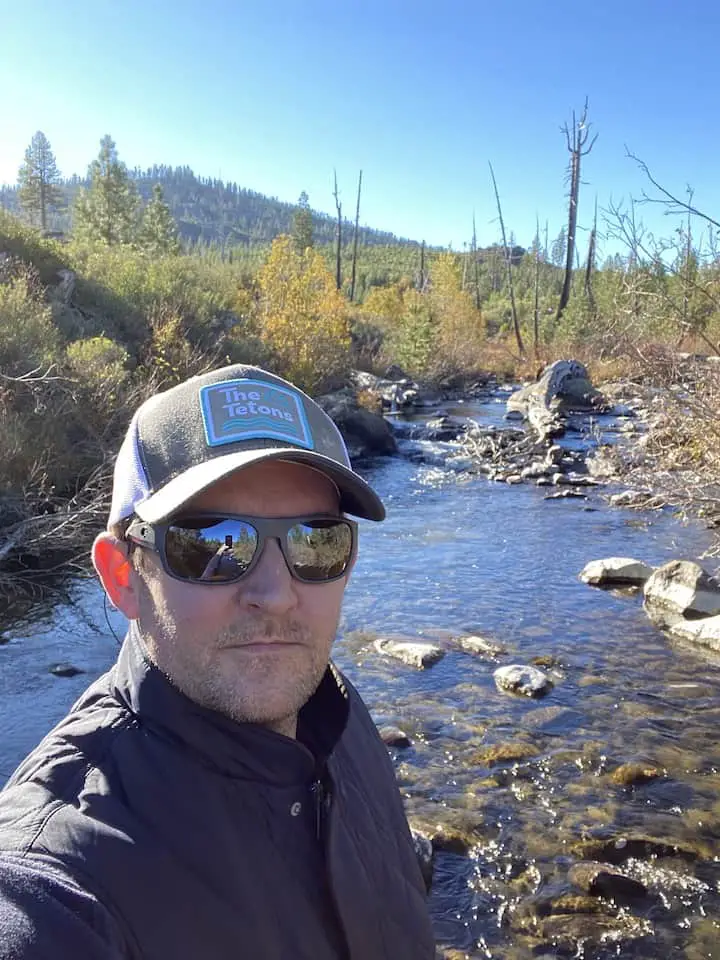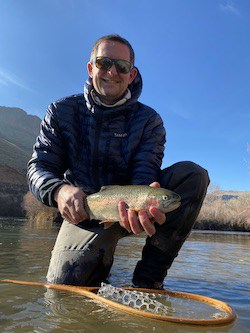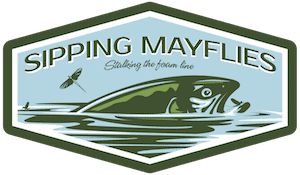Vital tips for safe wading while fly fishing
Feb. 10th, 2022
You always think it’ll be the other fly anglers who’ll slip and fall into the river. Those clowns are careless and not paying attention, right? It’s all so avoidable you tell yourself. If only they were as dexterous and attentive as you.
Newsflash: You’re going to fall into the river, and slip and trip on rocks–it’s just a matter of when. If you haven’t yet, you don’t spend much time on the water. That I can tell you.
I’m here to help you mitigate the number of times you get wet, or bruised, or both. I’ve put together the most comprehensive list of safe wading tips on the internet, and I’ll pepper in some stories that may entertain you.
Here’s a slick, algae-covered boulder just waiting for some unsuspecting (or overconfident) fly angler.

19 Safe wading tips for fly anglers
Here are a few tips for safely wading in higher river flows. Some are common sense, and others have been learned through experience.
- If your balance isn’t what it used to be, use a wading stick or staff. It might sound like a clumsy item to have to pack, but they’re collapsible and light now, so they take up very little room and weigh virtually nothing. While I’ve never used one, I’m sure I’ll eventually pick one up.
- Learn your river! This is mandatory if you fish at night, but even during the day it’s smart to know the underwater layout, the currents, the slippery spots, etc. This is common sense. Don’t be a hero in unknown waters.
- Wear a wading belt. Many fly fishing waders automatically come with wading belts nowadays, but not always. The theory is that if you slipped into the river, water would rush into your pant legs and make recovery more challenging. The snug wading belt, then, prevents the water from flowing into your waders. Lee Wulff challenged this theory, however, and jumped off a short bridge into deep water, wearing waders and no belt. He was fine and said this theory is false, but you can make your own decision. I always wear one.
- If you’re crossing a river, do so moving diagonally upstream. That way, if you run into trouble (gets too deep, fast, or unwadable), you can backtrack more easily. Backtracking moving downstream is much easier than backtracking working your way upstream (against the current).
- Standing sideways to the current whenever you’re wading across a river reduces the water friction you’ll encounter.
- When wading across a river, hold your rod in your downstream hand and allow it to dip into the water. This will help with your balance.
- Make sure your forward foot is solidly planted before moving your other foot.
- Use a PFD (Personal Floatation Device). I don’t know anyone who uses one of these, but it’s not a bad idea. I actually bought one but haven’t brought it out fishing. It’s a small device that will inflate a balloon-type contraption upon triggering. They’re inexpensive and if you fly fish around dangerous water, it might be worth considering.
- Fish with another person (the buddy system).
- Keep your phone in a sealed plastic bag.
- Use metal studded soles, or felt at a bare minimum. This makes a huge difference.
- Try to always stand with an athletic stance so that strong wind gusts, a big fish, or a noise behind you won’t cause you to suddenly lose your balance.
- Have an exit strategy in case you inadvertently slip into the river.
- Always wear polarized sunglasses so that you can see the bottom.
- Tying-in with the above tip, don’t wade if you can’t see the bottom.
- Don’t cast while you’re actively wading. You’re asking for trouble. I do it sometimes, and you will too, but we shouldn’t.
- During winter, watch for drifting ice sheets, and don’t stand facing downstream. These can be extremely dangerous.
- Avoid wading in mucky areas. Your feet can get stuck, making it much easier to fall over.
- Don’t stand on shoreline ice and cast into open water, no matter how tempting it may be.
Here’s some riverside ice that supported my weight (I’m 190lbs). How do I know? Because I stood on it over shallower areas and tried to bust it up. Regardless, it wasn’t safe–especially considering it extended out over a deep pool. There were trout rising just beyond the edges (fish use ice as cover). Not worth it. Don’t gamble with freezing river water.

July Whitewater Mishap
While this story isn’t specifically about wading, it is about fly fishing and water safety, so I’m going to share it.
About a year ago, a fly fishing club I am a part of decided to take some small Scadden rafts for a tour of the river. It was a hot July day, and there were seven of us. The flows would be nice and easy, according to the club owner [you already know where this is going].
But, I learned later that he hadn’t checked the flows–I had simply taken his word for it. This was a tailwater below a dam with fluctuating water levels. I also wasn’t familiar with this particular stretch of river.
We all wore life jackets, but no helmets. There were helmets available, but we wouldn’t need them because the flows would be “nice and easy.”
Starting out, the first 100 yards was pretty straightforward. Then I saw rapids, and not little ones. It turns out they were class III.
Things quickly got real. You know the feeling–that super intense focus.
I went over a drop and my Scadden flipped over backwards. Time slowed down. Into the river I went, completely under the whitewater. I came to the surface and swam to the shoreline. I didn’t experience any panic, just extreme focus. Thank God I didn’t hit my head on a boulder.
Once I got to shore, I caught the Scadden raft, flipped it over, and got back on. Stupid? Perhaps.
We all regrouped beyond the rapids, where I came to understand that the guys behind me were terrified when they saw me flip. Not for me, mind you, but for themselves. I think a couple of them were pretty shaken up.
The worst part was, I had my iPhone in my pocket. Since this was a “nice and easy” tour, I didn’t worry about keeping it dry. Long story short, my iPhone was ruined, and I lost two years worth of pictures. Two years. That’s another important tip, regularly back up your phone. I do it religiously now.
The main lessor here is obvious. Don’t trust what others tell you about water conditions. Do your own research, know your flows, and know your river.
Losing my footing
I was fly fishing by myself one September day in my favorite spot on one of my favorite rivers. It’s nestled in a steep canyon, and it’s really tough to get to–I eventually figured out a path through poison oak, blackberry bush thorns, trees, brush, fallen logs, and slick mountain rocks. Wading to the spot wasn’t possible because the water was too fast and deep.
I’ve never seen another human there, before or since.
It’s a serene, beautiful area. And no, you’re not getting a picture of it.
Often times, I’d spend quite a few hours there. It was full of powerful rainbow trout. The 17+ inchers could almost put me into my backing with long runs.
There was a section where I had to maneuver across a boulder that had an unusually flat surface that tilted at a 45-degree angle to the water. I’d traversed it many times, but this particular evening my legs slipped out from under me.
I started sliding towards the water and couldn’t grab onto anything. The water was deep, and there was a nasty rapid that began around six feet downriver from that spot.
My legs and torso slid right into the water, while my hands and forearms kept contact with the boulder. I remember my legs began to float, likely because of air trapped in my waders.
Once again, I was calm. Focused. I stabilized myself with my arms and hands, and began kicking my legs to help push myself back up onto the boulder.
I think about it somewhat often, especially around faster water, and I think that’s a good thing.
Don’t take your footing for granted. Slow down.
Here I am in some pocket water while doing some fly fishing in the fall. The rocks were very slippery, so I had to pay extra attention while wading. I wrote an article all about pocket water fly fishing that you should check out.

Deep Muck
Not too long ago, I was fly fishing a narrow mountain river (the same one in the above picture) that had become one of my go-to spots. It was scenic, the water was very wadable, the trout were active, and there were never any other anglers. It always made for a relaxing day.
On this particular day, I’d decided to work my way farther upstream than I’d ever gone. The river ended up winding through a quiet forested area where it narrowed considerably. It was completely silent, and frankly a little eerie.
I’d been hopping along the rocks and fallen trees, but when I stepped down onto the river bottom, my leg sank in several inches past my knee. It was like a thick, muddy silt.
I knew not to push down with my other foot because I would’ve driven it down into the muck just as deep. So I stopped, and considered my options.
Leaning over and grabbing onto a branch from a fallen tree, I was able to slowly pull both of my legs out of the muck.
Needless to say, I never went back to that area again.
Lesson learned: don’t assume a river bottom is solid, especially in slower water.
Summary
Spending time learning how to safely wade rivers is well worth your time as a fly angler. But much like school, you can only learn so much in the classroom. Much of what you learn will come from experience.
And as they saying goes, “Experience is the best teacher, but she’s also the most expensive.”
If you approach rivers nonchalantly, you’re going to get wet, or hurt, or both. It’s just a matter of time.
Wise anglers respect the river.

About the Author
My name's Sam and I'm a fly fishing enthusiast just like you. I get out onto the water 80+ times each year, whether it's blazing hot or snow is falling. I enjoy chasing everything from brown trout to snook, and exploring new waters is something I savor. My goal is to discover something new each time I hit the water. Along those lines, I record everything I learn in my fly fishing journal so I can share it with you.
Follow me on Instagram , YouTube, and Facebook to see pictures and videos of my catches and other fishing adventures!


